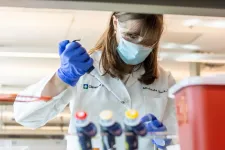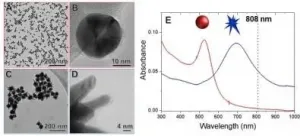Non-surgical treatment quickly reduces arthritis knee pain and improves function
Treatment provides long-term, safe option for disabling condition that affects millions
2021-03-16
(Press-News.org) FAIRFAX, Va. (March 16, 2021)-- A non-surgical treatment for arthritis in the knee is safe and effective in providing immediate and long-term pain relief, according to a new study to be presented at the Society of Interventional Radiology Annual Scientific Meeting. Genicular artery embolization (GAE) reduces inflammation in the knee to improve function and quality of life for people with moderate to severe knee pain. Osteoarthritis is one of most common causes of disability, limiting daily activities of 40% of all U.S. adults.
"Prior to treatment, patients' knee pain had taken over their whole life," said Siddharth A. Padia, MD, FSIR, professor of radiology, UCLA Health, and lead researcher of the study. "But after treatment, patients who initially could walk only three or four blocks were walking three miles. Some were able to do away with walking aids, such as canes, while others reported being in a better mood now that they were living without pain."
Until recently, arthritis pain was regarded as a "wear-and-tear" disease, but as the cartilage breaks down it releases enzymes that can cause inflammation and pain, and limit functioning. This treatment cuts down the abnormal blood flow to reduce inflammation. While it quickly improves patients' pain, even more exciting is that the pain relief is durable--lasting for at least 12 months.
This prospective, single-center, open-label FDA-approved study is the largest in the U.S. to evaluate the safety and efficacy of GAE for the treatment of osteoarthritis in the knee. The study included 40 patients who were not candidates for total knee replacement, but had failed to benefit from more conservative treatments, such as nonsteroidal anti-inflammatory drugs, joint injections and physical therapy.
Interventional radiologists navigated a catheter through a pinhole incision in the hip into the arteries in the arthritic knee. They then injected tiny particles to control the blood supply to inflamed and painful areas of the knee. The outpatient procedure took approximately one to two hours, followed by a two-hour recovery period. Each patient was evaluated for adverse events and pain scores at one week; one, three and six months; and one year after the treatment.
Patients saw benefits as soon as three days after the procedure. Average pain scores decreased from 8 out of 10 before GAE to 3 out of 10 within the first week. Additionally, seven in 10 patients reported more than 50% reduction in pain scores at the one-year follow up.
Minor temporary adverse events, such as transient skin discoloration and small bone infarct were reported in 10 patients, but resolved without treatment within days.
The researchers plan to conduct a randomized trial with a larger patient population to determine which patients may benefit most from the treatment, as well as the impact it has on slowing the progression of arthritis.
INFORMATION:
Abstract 16: Genicular Artery Embolization for the Treatment of Knee Osteoarthritis: Final Results from a Prospective Investigational Device Exemption Trial. S. Padia, A. Potnik, G. Blumstein, A. Stavrakis, E Zeegen, J. Moriarty, S. Genshaft. Annual Scientific Meeting, March 20-26, 2021. This abstract can be found at sirmeeting.org after the embargo time.
About the Society of Interventional Radiology
The Society of Interventional Radiology is a nonprofit, professional medical society representing more than 8,000 practicing interventional radiology physicians, trainees, students, scientists and clinical associates, dedicated to improving patient care through the limitless potential of image-guided therapies. SIR's members work in a variety of settings and at different professional levels--from medical students and residents to university faculty and private practice physicians. Visit sirweb.org.
The Society of Interventional Radiology is holding its Annual Scientific Meeting online March 20-26, 2021. Visit sirmeeting.org.
ELSE PRESS RELEASES FROM THIS DATE:
2021-03-16
In an analysis that explores the structural underpinnings of a SARS-CoV-2 strain, G614, that quickly became dominant early in the pandemic, researchers discovered interactions that prevent this strain's spike from shedding its host binding domain too early. This may explain the enhanced infectivity of the G614 virus, they say. Throughout the COVID-19 pandemic, epidemiologists have monitored evolution of the SARS-CoV-2 virus with particular focus on the spike (S) protein. Spike trimers decorate the viral surface and facilitate host cell entry. An early variant with a single-residue substitution ...
2021-03-16
March 16, 2021, PORT ST. LUCIE, FL: Researchers from Cleveland Clinic's Florida Research and Innovation Center (FRIC) have identified a potential new target for anti-COVID-19 therapies. Their findings were published in Nature Microbiology.
Led by FRIC scientific director Michaela Gack, Ph.D., the team discovered that a coronavirus enzyme called PLpro (papain-like protease) blocks the body's immune response to the infection. More research is necessary, but the findings suggest that therapeutics that inhibit the enzyme may help treat COVID-19.
"SARS-CoV-2 - the virus that causes COVID-19 - has evolved quickly against many of the body's well-known ...
2021-03-16
The storms, which consist of brightenings and broadenings of the dawn flank of an oval of auroral activity that encircles Jupiter's poles, evolve in a pattern surprisingly reminiscent of familiar surges in the aurora that undulate across Earth's polar skies, called auroral substorms, according to the authors.
The new study is the first to track the storms from their birth on the nightside of the giant planet through their full evolution. It was published today in AGU Advances, AGU's journal for high-impact, short-format reports with immediate implications spanning all Earth and space sciences.
During a dawn storm, Jupiter's quiet and regular auroral arc transforms into a complex and intensely bright auroral ...
2021-03-16
The market for air purifiers is booming, but a new study has found that some air cleaning technologies marketed for COVID-19 may be ineffective and have unintended health consequences.
The study, authored by researchers at Illinois Tech, Portland State University, and Colorado State University, found that cleaning up one harmful air pollutant can create a suite of others.
Both chamber and field tests found that an ionizing device led to a decrease in some volatile organic compounds (VOCs) including xylenes, but an increase in others, most prominently oxygenated VOCs (e.g., acetone, ethanol) and toluene, substances commonly found in paints, ...
2021-03-16
Those who have persistent trouble sleeping may have an especially difficult grieving process after the death of a loved one, a new study co-authored by a University of Arizona researcher finds.
Most people who lose a close friend or family member will experience sleep troubles as part of the grieving process, as the body and mind react to the stress of the event, said study co-author Mary-Frances O'Connor, a professor in the UArizona Department of Psychology.
But O'Connor and her collaborators found that those who had persistent sleep challenges before losing someone were at higher risk for developing complicated grief after a loss. Complicated grief is characterized by a yearning for a lost loved one ...
2021-03-16
It would surprise no one that pursuing a graduate degree can be a stressful endeavor, and for students who are transgender and nonbinary (TNB), the atmosphere can become toxic, according to University of Houston researcher Nathan Grant Smith. In a new paper published in Higher Education, Smith provides an analysis of current literature pertaining to TNB graduate student experiences and suggests interventions in graduate education to create more supportive environments for TNB students.
"Nearly 50% of graduate students report experiencing emotional or psychological distress during their enrollment in graduate school. Levels of distress are particularly high for transgender ...
2021-03-16
It has long been understood that a parent's DNA is the principal determinant of health and disease in offspring. Yet inheritance via DNA is only part of the story; a father's lifestyle such as diet, being overweight and stress levels have been linked to health consequences for his offspring. This occurs through the epigenome - heritable biochemical marks associated with the DNA and proteins that bind it. But how the information is transmitted at fertilization along with the exact mechanisms and molecules in sperm that are involved in this process has been unclear until now.
A new study from McGill, published recently in Developmental Cell, has made a significant advance in the field by identifying how environmental information is transmitted by ...
2021-03-16
Lightning strikes -- perhaps a quintillion of them, occurring over a billion years -- may have provided sparks of life for the early Earth.
A new study by researchers at Yale and the University of Leeds contends that over time, these bolts from the blue unlocked the phosphorus necessary for the creation of biomolecules that would be the basis of life on the planet.
"This work helps us understand how life may have formed on Earth and how it could still be forming on other, Earth-like planets," said lead author Benjamin Hess, a graduate student in Yale's Department of Earth & Planetary ...
2021-03-16
Lightning strikes were just as important as meteorites in creating the perfect conditions for life to emerge on Earth, geologists say.
Minerals delivered to Earth in meteorites more than 4 billion years ago have long been advocated as key ingredients for the development of life on our planet.
Scientists believed minimal amounts of these minerals were also brought to early Earth through billions of lightning strikes.
But now researchers from the University of Leeds have established that lightning strikes were just as significant as meteorites in performing this essential function and allowing life to manifest.
They say this shows that life could develop on Earth-like planets through the same mechanism at any time if atmospheric conditions are right. The research ...
2021-03-16
The activity of enzymes in industrial processes, laboratories, and living beings can be remotely controlled using light. This requires their immobilization on the surface of nanoparticles and irradiation with a laser. Near-infrared light can penetrate living tissue without damaging it. The nanoparticles absorb the energy of the radiation and release it back in the form of heat or electronic effects, triggering or intensifying the enzymes' catalytic activity. This configures a new field of study known as plasmonic biocatalysis.
Research conducted at the University of São Paulo's Chemistry Institute (IQ-USP) in Brazil investigated the activity of enzymes immobilized on gold ...
LAST 30 PRESS RELEASES:
[Press-News.org] Non-surgical treatment quickly reduces arthritis knee pain and improves function
Treatment provides long-term, safe option for disabling condition that affects millions




